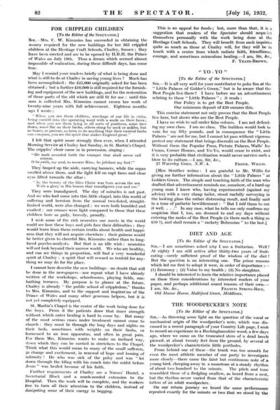THE WOODPECKER'S NOTE
[To the Editor of the SPECTATOR.]
SIR,—As throwing some light on the question of the vocal or mechanical origin of the woodpecker's note, which was dis- cussed in a recent paragraph of your Country Life page, I wish to record an experience in a Buckinghamshire wood, a few days ago, where we came on the truncated stem of a dead beech pierced, at about twenty feet from the ground, by several of the woodpecker's characteristic little portholes.
From behind one of these—the trunk was too smooth for even the most athletic member of our party to investigate more closely—there came the faint but continuous note of a young bird, cheeping away in a monotone at a steady rhythm of about two hundred to the minute. The pitch and tone resembled those of a fledgling swallow, as heard from a nest, but the rhythm never varied from that of the characteristic tattoo of an adult woodpecker._ .
On our return journey we heard the same performance repeated exactly for the minute or two that we stood by the
foot of the tree, and it seems to me that the natural conclusion is that we were listening to the note of a young woodpecker and that, as it was coming from the inside of the tree, it was manifestly a vocal and not a mechanical production.
It is strange that this question had not been finally settled by previous observation of a similar kind, but, as yet, I have not been able to find these recorded in any of the books on birds that I have had access to.
Further, the mechanical theory is not supported by any recorded variation in the note of the adult bird according to the depth it has reached in piercing its way inwards, for this would be bound to get gradually more muffled the deeper it Northwood, Middlesex.



































 Previous page
Previous page